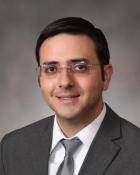Bradycardia is a term used when your heart beats more slowly than normal. Although your heart rate varies depending on your activity and your age, a consistently slow heart rate (less than 60 beats per minute) can cause problems if left untreated. Bradycardia is a form of arrhythmia.
Athletes and other people in good physical shape may have low resting heart rates (less than 50 beats per minute), but that is generally a sign of good heart health. If you do not fall into that category and you have bradycardia, something may be causing your heart’s sinus node — its natural pacemaker — to improperly send electrical signals that regulate your heartbeat.
If left untreated, bradycardia can cause the brain and other organs to not get the blood supply they need. Complications can include:
- Frequent fainting
- Heart attack
- Heart failure
- Seizures
- Stroke
The cardiologists at UK Gill Heart & Vascular Institute in Lexington, Ky., can treat bradycardia, along with any underlying conditions contributing to it. Our heart rhythm and arrhythmia specialists will ensure you receive the care you need.
The main symptom of bradycardia is an abnormally slow heart rate. But if you’re not monitoring your heart rate regularly with a device such as a smartwatch or fitness tracker, you may not know your heart rate has slowed down. However, you may experience symptoms such as:
- Chest pain
- Confusion or trouble concentrating
- Dizziness
- Fainting
- Fatigue
- Feeling tired easily when exercising
- Heart palpitations
- Shortness of breath
Bradycardia is not always preventable. But doing your best to maintain a heart-healthy lifestyle may help prevent the condition and other problems caused by heart disease. Take some of these steps:
- Eat a healthy diet. This includes eating fruits and veggies, lean meats, nuts, beans, fish and whole grains, while limiting sodium, added sugars and unhealthy fats.
- If you smoke, take steps to quit. Smoking can increase your risk for heart attack and stroke. Avoid vaping and secondhand smoke as well.
- Limit alcohol. Men should have no more than two drinks per day and women should aim for no more than one drink per day.
- Manage other health problems, such as high blood pressure and diabetes, by taking medications properly and following your provider’s guidance.
- Manage stress.
- Reach and maintain a healthy weight.
- Stay physically active. Try to get at least 30 minutes of moderate exercise most days of the week. Talk to your provider about what exercises are good for you. Be sure to watch for signs that your heart is working too hard. If you become short of breath or dizzy while exercising, stop and rest right away.
Your primary care provider or cardiologist can offer additional suggestions for your best heart health based on your personal medical history.
Anyone can develop bradycardia, but some people are at higher risk than others. Risk factors include:
- A family history of bradycardia
- Being 65 or older
- Epilepsy, hypothyroidism, sleep apnea or certain other medical conditions
- Heart disease
- High blood pressure
- Previous heart attack(s)
- Previous heart surgery
- Using alcohol or illicit drugs to excess
Bradycardia can also be caused by certain medications, such as beta blockers and calcium-channel blockers. Contracting Lyme disease may also increase your risk.
Your first visit to UK Gill Heart & Vascular Institute’s Adult Heart Rhythm Program is a time of education and introductions. You meet members of your care team and learn about detecting, treating and living with arrhythmias.
Diagnosing arrhythmias is a unique process that requires detective work. One of the most important steps toward diagnosis is listening to your story. Your team will ask a lot of questions about your symptoms and medical history. The goal is to gather all possible information that can help pinpoint the source of your heart issue. Information from this first meeting helps your team determine the next step in diagnosis.
Based on information from this meeting, your healthcare provider may give you a monitor to wear. This monitor tracks your heart rhythm and allows your team to determine the type of arrhythmia you have. Additionally, your team may prescribe one or more diagnostic tests. If appropriate, these tests take place on a different day, and your team helps schedule them at your convenience.
When coming to your first arrhythmia appointment, plan to do the following:
- Arrive early. You may need to fill out paperwork when you arrive. Getting to your appointment early ensures you have time to complete paperwork without feeling rushed.
- Bring a current list of medicines or supplements you take. You should also list any surgeries you’ve undergone, symptoms you’ve experienced and other past health issues.
- Dress comfortably. Working toward a diagnosis takes time. Comfortable clothes help you remain relaxed and attentive throughout your visit.
- Eat and drink normally. You won’t undergo imaging or other testing at your first visit. Therefore, there are no dietary restrictions.
- Have your insurance information on hand. UK HealthCare accepts most insurers, and financial assistance is available.
- Request a loved one to join you. Bring a family member or friend with you to take notes and ask questions you may not think of asking.
Where we are located
The UK Gill Heart & Vascular Institute is located at 800 Rose St. in Pavilion G, on the first floor of UK Albert B. Chandler Hospital. We will mail you a map and directions when your appointment is scheduled.
Patient drop-off
Patients can be dropped off in front of the main entrance to Albert B. Chandler Hospital at 1000 S. Limestone. If you are dropped off at the main entrance, you’ll enter the revolving doors on the ground floor of the hospital. Take the main stairs just to the left (or elevator across the atrium) to the first floor of Pavilion A.
After climbing the stairs or taking the elevator, turn left. You’ll pass the Kentucky Wall and Kentucky Children’s Hospital on your right. Continue to the end of the hall until it comes to a T shape. Turn left and the Gill clinic entrance is across from an open area housing the organ donor wall.
Parking
It is easiest to park in the UK HealthCare Parking Garage, across from the hospital at 110 Transcript Ave.
There are two paths from this garage to the Gill clinic:
- You may take the free shuttle from Level A of the parking garage. You’ll exit the shuttle at the Pavilion A/ Pavilion G stop in front of the main entrance to the hospital. After climbing the stairs or taking the elevator, turn left. You’ll pass the Kentucky Wall and Kentucky Children’s Hospital on your right. Continue to the end of the hall until it comes to a T shape. Turn left and the Gill clinic entrance is across from an open area housing the organ donor wall.
- From Level C of the parking garage you may walk or take a golf cart across the pedway to the first floor of Pavilion A. Turn left past the help desk and walk away from the dining hall. You’ll pass the Kentucky Wall and Kentucky Children’s Hospital on your right. Continue to the end of the hall until it comes to a T shape. Turn left and the Gill clinic entrance is across from an open area housing the organ donor wall.
If you need help finding your way, information desks are located inside the main entrances to Pavilion A, both on the ground floor and at the end of the pedway on the first floor. You may also call the information desk at 859-323-5816.
Our Adult Heart Rhythm Program experts help residents of Central Kentucky and beyond regain proper heart rhythm every day. To improve the future of arrhythmia treatment and management, they also participate in clinical trials.
At any given time, UK Gill Heart & Vascular Institute staff engages in trials for new medicines or devices. This gives you access to arrhythmia treatment not available at many other facilities.
If you’re a candidate for an ongoing trial, your care team will discuss the possibility with you.







